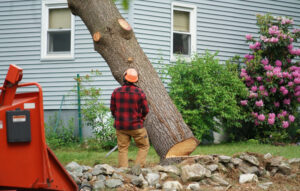Tree Removal Cost Calculator
Estimated Removal Cost: $0
This One Simple Trick Always Works for Negotiate Tree Removal Services
If you have a dangerous tree on your property and need it removed, learning how to negotiate with tree removal services can save you money and ensure a fair deal. This guide will walk you through the key questions to ask tree removal specialists, how to find free tree removal options, and tips on accessing free programs like those for seniors or government-funded initiatives aimed at preventing tree damage to infrastructure.
1. Understand Your Options for Free Tree Removal
Before negotiating, it’s helpful to know if you qualify for any free tree removal services. Some companies offer free removal in exchange for wood, while others participate in government programs that cover the cost for seniors or properties that pose a risk to public infrastructure. Researching these options first can provide leverage when negotiating with professional services.
2. Know the Market Rates
Prices for tree removal can vary widely depending on your location, the size and condition of the tree, and the urgency of the removal. Get multiple quotes from different companies to understand the going rates in your area. This information will give you a better idea of what’s reasonable and what might be overpriced.
3. Ask the Right Questions
When negotiating with tree removal professionals, ask specific questions to ensure you’re getting the best deal:
- What services are included? Make sure the quoted price includes all necessary services, such as stump grinding, debris removal, or cleanup.
- Are there additional costs? Check if there are any extra fees for hauling away large pieces of the tree or if there’s a charge for equipment use.
- Is the company insured? Verify that the company has insurance to protect against any damage that might occur during the removal process.
- Can you get a discount? Ask if they offer any discounts, especially if you’re a senior, veteran, or if you’re scheduling multiple services.
4. Highlight the Benefits to the Service Provider
Keep in mind that tree removal companies are often incentivized to take on jobs that provide them with usable wood or other materials. If your tree offers valuable wood, use this as a bargaining chip. Emphasize any benefits to the service provider, such as easy access to the tree or potential referrals for future business.
5. Negotiate with Confidence
When negotiating, remain polite but assertive. Let them know that you’re considering other quotes and services, which can encourage them to offer their best price upfront. Be clear about your budget and what you’re willing to pay.
6. Consider Timing and Flexibility
Tree removal companies often have peak seasons. If possible, schedule the removal during their slower periods when they might be more willing to negotiate on price. Additionally, if you’re flexible with the timing, you can often secure a better rate.
7. Get Everything in Writing
Once you’ve negotiated a price, ensure that all terms are documented in a written agreement. This should include the total cost, services provided, timeline, and any warranties or guarantees.
What Are the Questions to Ask Tree Removal Service Professionals?
Before hiring a tree removal service, it’s essential to ask the right questions to ensure you’re choosing a reliable and experienced company. Knowing these questions in advance can help reduce confusion and prevent potential issues. Here are key questions to consider:
- Do They Have Experience with Your Type of Trees?
Not all tree removal companies are familiar with every type of tree. Ask if they have experience with the specific type of tree you need removed. If they don’t, they might not know the safest way to handle the job, which could result in more damage to your property. - Do They Have Liability Insurance?
Liability insurance is a must for any tree removal service. This coverage protects you in case of accidents or damage that occurs during the removal process. Make sure the company’s insurance policy is adequate to cover any potential incidents on your property. - Does the Company Have Experience in Removing Trees Like Yours?
Similar to the first question, it’s important to ensure the company has specific experience with trees like yours, especially if they are large, old, or located in a difficult area. Lack of experience can lead to complications or accidents during removal. - Are There Additional Costs?
Ask if there are any extra fees for services like stump grinding, debris removal, or if special equipment is needed. Understanding all potential costs upfront helps you avoid unexpected charges. - Can They Provide References or Reviews?
Request references or check online reviews to gauge the company’s reputation and past performance. Positive feedback from previous customers can give you confidence in your choice. - What is Their Safety Protocol?
Inquire about the safety measures the company takes during tree removal. A professional service should follow industry standards and have safety protocols to protect both their workers and your property. - What is the Timeline for Completion?
Clarify how long the tree removal will take, from start to finish. Understanding the timeline helps you plan accordingly, especially if the tree poses a safety risk or you need the job completed by a specific date.
By asking these questions, you can better assess the qualifications of the tree removal service and ensure that you’re hiring a company that is capable, insured, and experienced, making the process smoother and more secure for your property.
What to Look for in a Tree Removal Company
If you need a tree removal service, you likely have many questions. Even if you’ve done your research and know what you want, finding the right company can be challenging. Here are some key factors to consider when selecting a tree removal service:
- Check the Company’s Reputation and Experience
A professional reputation is crucial. Look for a company that has been in business for at least five years, as this suggests they have the necessary experience and are likely doing something right to stay in the industry. - Inquire About Their Services
Ask about the range of services they offer. Do they provide stump grinding, mulching, or other related services? Understanding their capabilities can help you get the best value for your money. Also, inquire about the types of trees they specialize in removing and the size of their team. - Ensure They Are Licensed and Insured
Verify that the company is licensed to operate in your area. This guarantees they meet local regulations and standards. Additionally, check that they have adequate insurance coverage to protect against accidents or damages that may occur during the tree removal process.
Can You Negotiate Tree Removal?
Yes, you can negotiate tree removal services! Here’s how to approach it:
- Discuss Your Needs Clearly
Communicate your requirements with the company upfront. Some companies might provide a price quote immediately, while others may need to assess the situation further before giving a final price. - Stay Engaged Throughout the Process
Keep in regular contact with the service provider to ensure that there are no surprises in the final bill. Being transparent about your expectations can help prevent misunderstandings or unexpected costs. - Negotiate Specifics
Once communication is established, start the negotiation process. Clearly outline what you need, including how much time each step will take and any necessary equipment. Ask questions such as, “Do you have the right personnel for this job?” or “What would be the most cost-effective approach to get this done?”
Does a Tree Removal Agreement Between Neighbors Work?
Negotiating tree removal with your neighbors can be a delicate process. If successful, it can enhance the look and feel of your community. Here’s how to approach it:
- Understand the Importance of Trees
Trees add aesthetic and environmental value to a neighborhood, providing shade, reducing pollution, and increasing property values. However, there are times when removal is necessary due to safety, aesthetics, or maintenance concerns. - Tips for Negotiating with Neighbors
- Initiate early discussions with your neighbors about tree removal.
- Get to know your neighbors and their preferences regarding trees.
- Be willing to compromise and find common ground that satisfies all parties.
- Keep emotions in check to reach a mutually agreeable solution.
How to Make a Tree Removal Agreement Between Neighbors
When you and your neighbor decide that a tree needs to be removed, ensure clear communication and agreement on the process:
- Mark Trees Clearly
Ensure that all trees slated for removal are clearly marked. Look out for signs of potential dangers like damaged branches or weak spots. - Plan and Schedule the Work
Allow sufficient time for the job, typically at least two hours per tree, and plan ahead by scheduling any necessary equipment. - Inform Neighbors About the Equipment Used
Make sure your neighbors are aware of the type of equipment that will be used so they can keep an eye on their property during the job.
How to Deal with Tree Roots Above Ground
If you’re dealing with tree roots above ground, it can be frustrating, but there are steps you can take:
- Identify the Source
Determine where the roots are coming from—old trees, nearby waterways, or poorly maintained areas could be contributing factors. - Take Action
Use herbicides around the roots to prevent regrowth, or a root pruner to trim problematic roots without damaging healthy parts of the tree.
How to Choose a Tree Removal Service
Choosing the right tree removal service involves careful consideration. Here are some tips:
- Determine the Type of Service You Need
Whether it’s removing a dead tree, pruning, or trimming, select a company experienced in handling your specific needs. - Check Customer Reviews
Look for companies with positive feedback and high ratings from previous customers. Reviews can give insights into the quality of service you can expect. - Ensure They Have Local Experience
A company familiar with your area is more likely to understand the local landscape and regulations, leading to smoother operations. - Verify Licensing and Insurance
Always confirm that the tree removal service is properly licensed and insured, providing peace of mind that you’re working with professionals.
How to Request a Tree Removal
To request a tree removal, it’s best to consult an arborist certified by the International Society of Arboriculture (ISA). They can guide you through the process, ensuring that the removal is done safely and in accordance with local regulations:
Contact a certified arborist who holds certification from the International Society of Arboriculture (ISA).
Provide details about your property, including its location, the size and species of the trees, and any potential risks they may pose to people or property.
Additionally, share information about your current landscaping and drainage systems if relevant.
The arborist will conduct an inspection of the trees on your property to assess which ones can be safely removed, aiming to minimize damage and reduce any risks during the removal process.
What Are the Tips for Negotiating Tree Removal?
Negotiating tree removal is an important part of real estate development, but it can also feel stressful and time-consuming. Fortunately, there are ways to make the process smoother and get the best results from your tree removal company.
Step 1: Be Prepared
Start by doing your homework. Learn about the types of trees that need to be removed, including their size and location. Knowing this information will help you avoid wasting time with companies that aren’t suited for the job.
Step 2: Consider the Value of Your Trees
Think about how the trees impact the area. Large, old trees in busy spots might not be as valuable as those near schools, residential neighborhoods, or small businesses where their presence is more appreciated.
Step 3: Negotiate the Price
Before agreeing to anything, negotiate the price with the tree removal company. This way, everyone has clear expectations, making the process easier and smoother when it comes time to pay.




